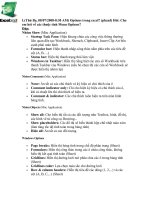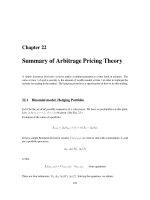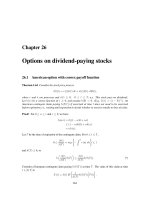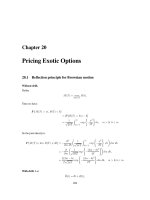Pricing Exotic Options
Bạn đang xem bản rút gọn của tài liệu. Xem và tải ngay bản đầy đủ của tài liệu tại đây (157.28 KB, 14 trang )
Chapter 20
Pricing Exotic Options
20.1 Reflection principle for Brownian motion
Without drift.
Define
M T = max
0tT
B t:
Then we have:
IP fM T m;BTbg
=IPfBT2m,bg
=
1
p
2T
Z
1
2m,b
exp
,
x
2
2T
dx; m0;bm
So the joint density is
IP fM T 2 dm; B T 2 dbg = ,
@
2
@m @b
1
p
2T
Z
1
2m,b
exp
,
x
2
2T
dx
!
dm db
= ,
@
@m
1
p
2T
exp
,
2m , b
2
2T
!
dm db;
=
22m , b
T
p
2T
exp
,
2m , b
2
2T
dm db; m0;b m:
With drift. Let
e
B t=t + Bt;
209
210
shadow path
m
Brownian motion
2m-b
b
Figure 20.1: Reflection Principle for Brownian motion without drift
m=b
b
m
(B(T), M(T)) lies in here
Figure 20.2: Possible values of
B T ;MT
.
CHAPTER 20. Pricing Exotic Options
211
where
B t; 0 t T
, is a Brownian motion (without drift) on
; F ; P
.Define
Z T = expf,B T ,
1
2
2
T g
= expf, B T +T +
1
2
2
Tg
= expf,
e
B t+
1
2
2
Tg;
f
IPA=
Z
A
ZTdIP; 8A 2F:
Set
f
M T = max
0tT
e
B T :
Under
f
IP;
e
B
is a Brownian motion (without drift), so
f
IP f
f
M T 2 d ~m;
e
B T 2 d
~
bg =
22 ~m ,
~
b
T
p
2T
exp
,
2 ~m ,
~
b
2
2T
d ~md
~
b; ~m0;
~
b ~m:
Let
h~m;
~
b
be a function of two variables. Then
IEh
f
M T ;
e
BT =
f
IE
h
f
M T ;
e
B T
Z T
=
f
IE
h
h
f
M T ;
e
B T expf
e
B T ,
1
2
2
T g
i
=
~m=1
Z
~m=0
~
b=~m
Z
~
b=,1
h~m;
~
b expf
~
b ,
1
2
2
T g
f
IP f
f
M T 2 d ~m;
e
B T 2 d
~
bg:
But also,
IEh
f
M T ;
e
BT =
~m=1
Z
~m=0
~
b=~m
Z
~
b=,1
h~m;
~
b IPf
f
MT 2 d~m;
e
BT 2 d
~
bg:
Since
h
is arbitrary, we conclude that
(MPR)
IP f
f
M T 2 d ~m;
e
B T 2 d
~
bg
= expf
~
b ,
1
2
2
T g
f
IP f
f
M T 2 d ~m;
e
B T 2 d
~
bg
=
22 ~m ,
~
b
T
p
2T
exp
,
2 ~m ,
~
b
2
2T
: expf
~
b ,
1
2
2
T gd ~md
~
b; ~m0;
~
b ~m:
212
20.2 Up and out European call.
Let
0 K L
be given. The payoff at time
T
is
S T , K
+
1
fS
T Lg
;
where
S
T = max
0tT
S t:
To simplify notation, assume that
IP
is already the risk-neutral measure, so the value at time zero of
the option is
v 0;S0 = e
,rT
IE
h
ST , K
+
1
fS
T Lg
i
:
Because
IP
is the risk-neutral measure,
dS t=rS t dt + S t dB t
S t=S
0
expfBt+r,
1
2
2
tg
= S
0
exp
8
:
2
6
6
6
4
B t+
r
,
2
| z
t
3
7
7
7
5
9
=
;
= S
0
expf
e
B tg;
where
=
r
,
2
;
e
B t=t + Bt:
Consequently,
S
t=S
0
expf
f
M tg;
where,
f
M t = max
0ut
e
B u:
We compute,
v 0;S0 = e
,rT
IE
h
ST , K
+
1
fS
T Lg
i
= e
,rT
IE
S 0 expf
e
B T g, K
+
1
fS0 expf
e
M T g Lg
= e
,rT
IE
"
S 0 expf
e
B T g,K
1
e
BT
1
log
K
S 0
| z
~
b
;
e
M T
1
log
L
S 0
| z
~m
CHAPTER 20. Pricing Exotic Options
213
(B(T), M(T)) lies in here
M(T)
B(T)
x
y
b
m
~
~
~
~
x=y
Figure 20.3: Possible values of
e
B T ;
f
M T
.
We consider only the case
S 0 KL;
so
0
~
b ~m:
The other case,
KS0 L
leads to
~
b0 ~m
and the analysis is similar.
We compute
R
~m
~
b
R
~m
x
: : : dy dx
:
v 0;S0 = e
,rT
Z
~m
~
b
Z
~m
x
S0 expfxg, K
22y , x
T
p
2T
exp
,
2y , x
2
2T
+ x ,
1
2
2
T
dy dx
= ,e
,rT
Z
~m
~
b
S0 expfxg,K
1
p
2T
exp
,
2y , x
2
2T
+ x ,
1
2
2
T
y=~m
y=x
dx
= e
,rT
Z
~m
~
b
S 0 expfxg,K
1
p
2T
"
exp
,
x
2
2T
+ x ,
1
2
2
T
, exp
,
2 ~m , x
2
2T
+ x ,
1
2
2
T
dx
=
1
p
2T
e
,rT
S 0
Z
~m
~
b
exp
x ,
x
2
2T
+ x ,
1
2
2
T
dx
,
1
p
2T
e
,rT
K
Z
~m
~
b
exp
,
x
2
2T
+ x ,
1
2
2
T
dx
,
1
p
2T
e
,rT
S 0
Z
~m
~
b
exp
x ,
2 ~m , x
2
2T
+ x ,
1
2
2
T
dx
+
1
p
2T
e
,rT
K
Z
~m
~
b
exp
,
2 ~m , x
2
2T
+ x ,
1
2
2
T
dx:
The standard method for all these integrals is to complete the square in the exponent and then
recognize a cumulative normal distribution. We carry out the details for the first integral and just









